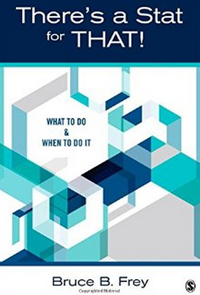New book shows 'There's a Stat for That'
LAWRENCE — Researchers around the world attempt difficult questions every day in fields from cancer research to psychology to educational measurement. Getting caught up in the question of which method of statistical analysis is right for their study, especially if it has been awhile since their stats courses, can unfortunately complicate matters further. A new book by a University of Kansas professor could ease that complication by proving “There’s a Stat for That.”
 Bruce Frey, associate professor of psychology and research in education, has authored “There’s a Stat for That! What to Do and When to Do it.” The book serves as a guideline to help researchers, faculty and grant writers determine which method of analyzing data is right for their particular study design.
Bruce Frey, associate professor of psychology and research in education, has authored “There’s a Stat for That! What to Do and When to Do it.” The book serves as a guideline to help researchers, faculty and grant writers determine which method of analyzing data is right for their particular study design.
“As a field we probably do a good enough job of teaching people how to actually do statistical analyses. But I think even good statistical students and people who teach them don’t always make the connection at the beginning between their group and measurement design and the type of analysis that serves it best,” Frey said.
 The book is a brief, straightforward guide that asks basic questions about the type of research, and it provides concise descriptions of 40 types of analyses. An opening table asks users how many dependent and independent variables their study has, how they are measured and how many measurement occasions there are.
The book is a brief, straightforward guide that asks basic questions about the type of research, and it provides concise descriptions of 40 types of analyses. An opening table asks users how many dependent and independent variables their study has, how they are measured and how many measurement occasions there are.
“Knowing just those three things can lead you to the one best statistic to use,” Frey said.
Readers then are directed to one of the book’s 40 two-page chapters examining their determined method. Each chapter contains a summary of the method, brief explanation of the research design, what output to expect, examples of previous studies that have utilized the method and tips to consider when using the procedure.
The idea is not to teach people how to conduct statistical analyses — there are unlimited books, websites, software, resources and excellent teachers that do that already, Frey said — but to simply help people determine which method to use.
Statistics classes often focus on a single type of analysis, devoting full attention to multiple regression analyses or analysis of variance models, for example. Graduate students, professionals and grant writers are among the groups who will likely benefit the most from the book, Frey said. If someone only knows how to use one approach, or is passingly familiar with another, didn’t completely grasp it or has not used that analytical method in some time, it can limit the research questions he or she considers. That, in turn, can limit the quality of research. The book can help researchers design studies that truly examine their hypothesis instead of designing research around methods with which they are already familiar.
Frey has extensive experience researching and writing about statistical design, classroom assessment and instrument development. His previous books include “Modern Classroom Assessment" and “100 Questions (and Answers) About Tests and Measurement," and he is the co-editor of the Encyclopedia of Research Design.
Frey compares the book to giving someone insight on chess expertise. Whereas a novice chess player examines the entire board, considering every space and every piece, an expert can see the patterns of games as they unfold and knows how to act and react based on the flow of the game.
“This book essentially gives people the expert system,” Frey said. “It shouldn’t be secret knowledge to know which statistical analysis is the right one for your design. By just asking a few questions, one can know which stat is right for that.”